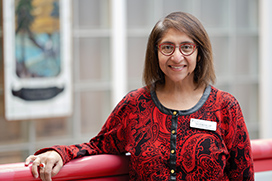Real-world exposure key for students at H.A. Leeper Speech and Hearing Clinic
Hands-on experience provides practical skills for graduate students as well as a needed service in the local community
By Todd Devlin
Taslim Moosa is a big proponent of the integrated model offered to her graduate students. Those enrolled in Western's Speech-Language Pathology and Audiology programs receive both classroom learning and clinical experience on-site – thanks to the H.A. Leeper Speech and Hearing Clinic.
Moosa likes to use the metaphor of a bridge – one that connects learning in the classroom with the hands-on experience students acquire in the clinic. That metaphor extends to the clinic itself, which bridges the university with the larger community.
“I really appreciate that we have a role in the community. Having a teaching clinic allows us to offer services at a very reasonable rate. It serves our mandate, and it’s a service back to the community,” says Moosa, a clinical lecturer and supervisor in the School of Communication Sciences and Disorders.
“There are few places in London or even southwestern Ontario, that see clients with voice disorders, for instance. There are few services for people who stutter – unless you can afford private therapy. So, I think the H.A. Leeper Clinic provides a huge service to the community.”
On the audiology side, services at the clinic include hearing assessments, hearing aid fitting, and programs geared towards age-related hearing loss. On the speech-language pathology side, services are available for adults who have suffered a stroke or have other neurological diagnosis that cause speech and language challenges. In addition, services are offered to those living with voice disorders, fluency disorders (stuttering) and preschool children with a range of speech and language difficulties.
“I really appreciate that we have a role in the community. Having a teaching clinic allows us to offer services at a very reasonable rate. It serves our mandate, and it’s a service back to the community.”
Students become familiar with the H.A. Leeper Clinic quite quickly. Early in their professional training, the students get the opportunity to have placements at the on-site clinic, working with their supervisors to gain hands-on experience with clients.
“We’re a teaching clinic, so every client I see, I have students with me,” says Moosa, who has been working in the clinic for 19 years. “I meet with them in the classroom, I do a certain amount of teaching and preparation, they read the case files with me, and then we see the clients together.”
That’s the standard model: Two students, a supervisor and one client. As students progress in their learning, they become more independent with clients, requiring less supervision. With the clinic’s one-way mirrors, supervisors are able to observe and offer feedback, while fostering independence and growth.
“We have a systematic process, where the ownership (progressively) goes to the student. They’re running the session, the client can’t see me but I can see everything through the windows. I’m writing feedback to the student, and if needed I can jump in and model something. It really becomes a laboratory of teaching.”
The clients, Moosa says, enjoy being part of the learning environment. Sessions often take on more of a ‘team’ feeling, with students and clients working together in therapy sessions.
“They get involved in the teaching. One of my 12-year-old clients who stutters … part of his therapy is to talk about his stuttering and learn how to describe it. He taught the students how to use the techniques. He’s proud to be part of the education process.”
Bidushy Sadika is a client who can relate. She’s been accessing the clinic since last January for her own stuttering issues. Born and raised in Bangladesh, and then Saskatchewan for her high school years, Sadika moved to London in September 2021 to pursue a PhD.
“I felt a friendly vibe, and I really liked the environment,” Sadika says of her first trip to the H.A. Leeper Clinic. “I felt like I could talk about my issues. Their focus is more therapy-based and doesn’t have a ‘medical’ feel. They don’t just focus on my speech, but also the factors around my speech … my anxiety and the social factors.”
Working with students (and their supervisor) at the Leeper Clinic, Sadika has learned tools and techniques to help with her speech – for instance, pausing in between sentences, or repeating a word if she gets stuck. This allows her the time to form the sentence in her head.
“These are strategies I do that help me. I also get to practice talking to strangers at the clinic, which is really helpful. Or I’ll read paragraphs from a book, or even call someone on the phone. After the therapy, we get homework that I have to practice each day.”
Sadika is happy with her progress, and she’s enjoyed working with the students at the Leeper Clinic. She says she sees the value in the hands-on experience students get working with clients, and she’s happy to be part of the process.
“They are getting real-world exposure working with clients … learning what a client’s issues are and how to interact with them,” she said. “I don’t ever feel I’m a ‘patient.’ It’s more of a team-based approach where I go there, talk to them, and practice the tools.”
This type of atmosphere is one that Moosa embraces. That bridge, from classroom to clinic – and from clinic to community – is one paved with mutual respect, understanding, and a desire to work together to improve the wellbeing of clients.
“Our model is to embed education into our healthcare provision,” says Moosa. “We have a role in the community, and the community has a role with us, because they help us educate the next generation. Our clients say they’re so pleased to be part of the education system. It’s really an amazing relationship (between clinician and client) at a teaching clinic.”


